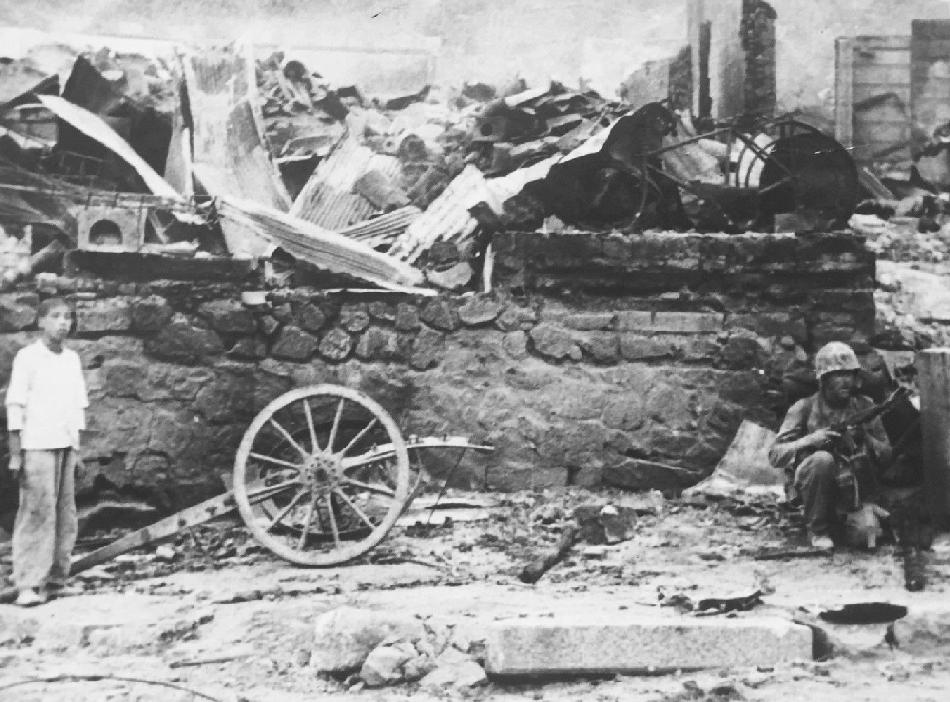
The Korean War: The Fight for Seoul (September 1950)

Figure 1.--Seoul was not badly damaged when the Noth Koreans invaded South Korea (June 1950). Liberating Seoul was a different matter. Some 20,000 NKPA troops retreating from Inchon made a stand there. The city was essentially reduced to rubble in the process of liberating it. The press caption hee read, "Freedom on the Alert: While a member of the 1st Marine Division (right) stays covered up and on the alert from possible enemy sniper, a young Korean boy stands dazed and bewildered (left) after U.N. troops fought their way into Seoul, driving th North Koreans out of the city. Note the almost complete destruction evident in the photo." The caption is not entirely ccurate. The U.N. troops were almost entirely American. And the Noth Koreans were not driven out of the city. The NKPA that fought their were mostly killed or wounded. The city was declared secured Sptember 25. Fighting continued, however, for some time. This photograph was dated October 2. The destruction and loss of life was tragic. Put your cursor on the image to see wht the sacrifice of young Americans made possivle for the Korean people. For the full view click here.
|
|
Heavy fighting with NKPA units occured on the southern outskirts of Seoul. At the time the Inchon landings began, the NKPA had only one understrength division in the city itself. The bulk of the NKPA forces in the area were south of Seoul attempting to crack the Pusan Perimiter. This also was where the U.N. forces were located, hanging onto the Pusan Perimiter. General MacArthur personally conducted the assualt in Seoul, carried out by the 1st Marine Regiment. Gen. Almond was given control of Operation Chromite. The Marines entered Seoul (September 17). The North Koreans decided to make a fight for Seoul and did not immeditaely begin to move its forces in the south northward. The goal of breaking into the Pusan Perimiter was Kim's obsessive focus. The North Korean forces available to put up a fight in Seoul were limited. The NKPA moved limited available reinforcenents into the city and attempted to fortify it. There was, however, little time and Kim Il-Sung was reluctant to give up the fight around Pusan where he thought victory was near. As a result, the NKPR did not immediately disengage in the south and begin a retreat north. NKPR units driven back from Inchon poured into Seoul, but with few heavy weapons or supplies. In all about 20,000 NKPR troops made a fight for the capital. [Malkasian, p. 27.] The result was desperate house-to-house fighting and extensive America artillery and air support leveled areas where the NKPR fidhters attemted to resist. Air support included both high-explosives and napalm. The Marines began the liberation of Seoul. Major-Feneral O.P. Smith commanded the Marine Division. He launched a two-pronged assault from the north and southwest. The norther proong largely cut off NKPR reinforcement and supply. The Marines took the Kimpo Airfield (September 18). Gen. Almomd decided to commit the 7th U.S. Divisions 32nd regiment which attacked from the southeast. Several days of bitter hand-to-hand fighting ensued. Civilians had little time to flee and there were heavy casualties. Although surroundedand outgunned, the NKPR soldiers fought 'fanatically'. Suiside squads rushed amercan tanks. Gen. Almond declared the city liberated (September 25). The American and U.S. flags were raised over the batter capitol. [Malkasian, p. 27.] The Marines, however, still had to engage NKPR holdouts in house-to-house combat and taking casualties into early-October. There had been some damage with the initial North Koream invasion (June 1950). That was nothing like what occurred during the Second Battle for Seoul. The city as a result was left a smoldering pile of rubble.
Sources
Malkasian, Carter. The Korean War 1950-1953.
CIH

Navigate the Children in History Website:
[Return to Main liberation of Seoul page]
[Return to Main Korean War page]
[Return to Main specific war and crisis page]
[Return to Main early Cold War period page]
[Return to Main Korean history page]
[Introduction]
[Animals]
[Biographies]
[Chronology]
[Climatology]
[Clothing]
[Disease and Health]
[Economics]
[Geography]
[History]
[Human Nature]
[Law]
[Nationalism]
[Presidents]
[Religion]
[Royalty]
[Science]
[Social Class]
[Bibliographies]
[Contributions]
[FAQs]
[Glossaries]
[Images]
[Links]
[Registration]
[Tools]
[Children in History Home]
Created: 3:00 PM 10/20/2015
Last updated: 3:00 PM 10/20/2015



